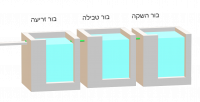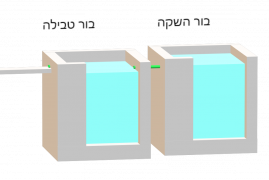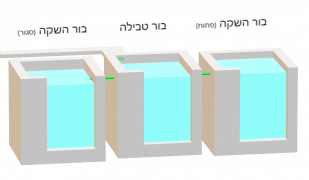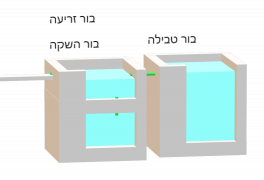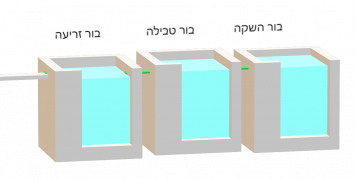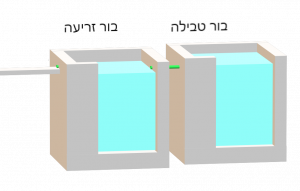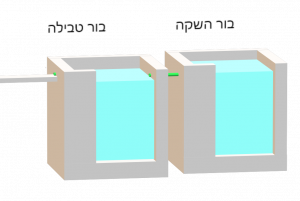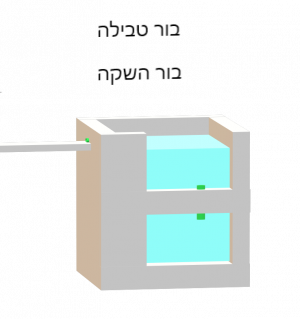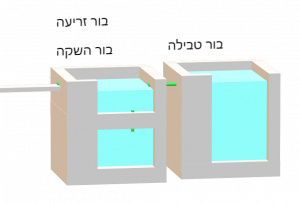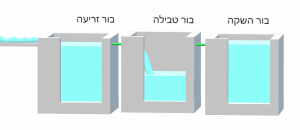Modern Mikvaot: Difference between revisions
From Halachipedia
| Line 25: | Line 25: | ||
== Two borot using zeriya == | == Two borot using zeriya == | ||
[[Image:Mikva_two_borot_zeriya.png|right|300px|Two borot (Chatom Sofer, Chazon Ish)]] | [[Image:Mikva_two_borot_zeriya.png|right|300px|Two borot (Chatom Sofer, Chazon Ish)]] | ||
# Chatom Sofer 214 holds that the best way to make a mikveh is to use zeriya. | # Chatom Sofer (YD 203, 212, 214) holds that the best way to make a mikveh is to use zeriya. One positive is that there’s no question of fulfilling the opinion of [https://beta.hebrewbooks.org/reader/reader.aspx?sfid=11651#p=437&fitMode=fitwidth&hlts=&ocr= Rabbenu Yerucham (26:5 226a)] to have continuous hashaka. [Another benefit is that hashaka with sheuvim is questionable (Tosfot Rid and Kesef Mishna) and zeriya is firmly established.] | ||
# The downside of such an approach is natan seah vnatal seah (Rambam and Raavad against Rash and Rosh) and some hold that this issue is solved since there’s no obvious act of taking away water (Ramban, Bet Yosef). In fact, Chazon Ish (Likutim 3) recommended doing just a bor zeriya and bor tevila. He held that this is kosher and the best option. However, The Divrei Chaim disputes this point and shows that the Raavad would invalidate the mikveh because of natan seah vnatal seah even if it isn’t evident. | |||
## Maharshag YD 65 defends Chatom Sofer about problems of natan seah vnatal seah. He suggests doing zeriya into pit two and spill over into tevilah pit then hashaka once with pristine hashaka bor. He says that the issue of natan seah doesn’t apply to the tevilah bor since the drawn water was added to the other pit and only overflowed there. | ## Maharshag YD 65 defends Chatom Sofer about problems of natan seah vnatal seah. He suggests doing zeriya into pit two and spill over into tevilah pit then hashaka once with pristine hashaka bor. He says that the issue of natan seah doesn’t apply to the tevilah bor since the drawn water was added to the other pit and only overflowed there. | ||
## Mishna Halachot 10:146 said that zeriya in second pit is only effective if it is first still and then spilled over. Cheshev Sofer YD 13 said that was the minhag to do. | ## Mishna Halachot 10:146 said that zeriya in second pit is only effective if it is first still and then spilled over. Cheshev Sofer YD 13 said that was the minhag to do. | ||
## Satmer Rav in Divrei Yoel 69 said you can do zeriya with bor al gabi bor and have it overflow into bor tevilah. Mishna Halachot 10:146 said it is pasul since the katafras makes it not connected to a mikveh and zochlin is invalid for zeriya so both mikvehs become invalid. | ## Satmer Rav in Divrei Yoel 69 said you can do zeriya with bor al gabi bor and have it overflow into bor tevilah. Mishna Halachot 10:146 said it is pasul since the katafras makes it not connected to a mikveh and zochlin is invalid for zeriya so both mikvehs become invalid. | ||
## Igrot Moshe YD 2:94 writes that you shouldn’t just do zeriya because of natan seah vnatal seah. In Igrot Moshe 1:112 he writes that it isn't really necessary to be concerned for the Raavad and so this is kosher technically speaking. | ## Igrot Moshe YD 2:94 writes that you shouldn’t just do zeriya because of natan seah vnatal seah. In Igrot Moshe 1:112 he writes that it isn't really necessary to be concerned for the Raavad and so this is kosher technically speaking. | ||
#Chazon Ish (Lukkutim 3:1) held that the pipe with tap water should be higher than the hashaka pipe connecting the bor zeria and bor tevila. Otherwise while filling the bor zeriya, the water in the bor zeriya would immediately be overflowing into the bor tevila. The issue with that if water is leaving the bor zeriya then its water is considered zochlin. It is questionable if hashaka can be accomplished to zochlin water. However, if the tap water pipe is lower than the hashaka pipe, then first the tap water would go into the bor tevila while there is 40 seah of stationary water. According to Rosh, that bottom water below the area where it is leaving isn't considered zochlin. Therefore, it is fine to rely on those who allow hashaka to zochlin water since according to Rosh it isn't zochlin at all. | |||
#Chazon Ish (Tinyana 4:10) wrote that if Raavad is strict to require 40 seah of original rainwater then he would also require continuous hashaka (like Tzemech Tzedek). However, if Raavad is only based on marit ayin that temporary hashaka is fine. He holds that we're only strict for the opinion of Raavad because of marit ayin. Chazon Ish (Likkutim 3) repeats this but isn't certain if the two issues of Raavad and Rabbenu Yerucham are related. | |||
== Two borot using hashaka == | == Two borot using hashaka == | ||
| Line 36: | Line 39: | ||
## Rav Moshe (Igrot Moshe 1:112) writes that this mikveh is technically kosher and it isn't necessary to be strict for the Rabbenu Yerucham. | ## Rav Moshe (Igrot Moshe 1:112) writes that this mikveh is technically kosher and it isn't necessary to be strict for the Rabbenu Yerucham. | ||
## Igrot Moshe YD 2:94 approves of this type of mikveh to solve the issue for Rambam and Raavad since momentary hashaka works for natan seah vnatal seah. However, the Tzemech Tzedek 171 argues that this doesn’t actually solve the Rambam and Raavad either because they certainly would accept Rabbenu Yerucham as they fundamentally need the presence of 21 seah. [Problematically, the Divrei Chaim 201:20 himself makes the same point as the Tzemech Tzedek.] Because of this point, Rabbi Moshe Bick (Taharat Yom Tov 8:27) convinced the Satmer rebbe to hold like the Chabad mikveh. | ## Igrot Moshe YD 2:94 approves of this type of mikveh to solve the issue for Rambam and Raavad since momentary hashaka works for natan seah vnatal seah. However, the Tzemech Tzedek 171 argues that this doesn’t actually solve the Rambam and Raavad either because they certainly would accept Rabbenu Yerucham as they fundamentally need the presence of 21 seah. [Problematically, the Divrei Chaim 201:20 himself makes the same point as the Tzemech Tzedek.] Because of this point, Rabbi Moshe Bick (Taharat Yom Tov 8:27) convinced the Satmer rebbe to hold like the Chabad mikveh. | ||
## Chazon Ish (Likkutim 3) has technical problems with this type of mikveh because (1) the hashaka pit isn't changed and gets very dirty. It isn't proper to use dirty water for a mitzvah of tevilah, (2) someone might make a mistake and empty the hashaka pit, (3) chlorine might be added to the hashaka pit to mitigate the bad smell and if there's two much chlorine it could invalidate the bor hashaka. | |||
== Three borot using hashaka == | == Three borot using hashaka == | ||
| Line 41: | Line 45: | ||
# One to connect one time and one to keep open. Mishna Halachot 10:146 writes that’s the minhag of Ungar and Galisiya was like Divrei Chayim to build 3 pits, two for hashaka, one that was temporary and one that was continuous. He answered the Tzemech Tzedek by saying that although the Raavad would agree with Rabbenu Yerucham that’s only for a mikveh made completely with drawn water, but not for a mikveh that is just invalid because of natan seah vnatal seah. That can be fixed with a momentary hashaka. Divrei Yatziv YD 117 agrees that the minhag is to have 3 pits, one open all the time and one opened only momentarily. | # One to connect one time and one to keep open. Mishna Halachot 10:146 writes that’s the minhag of Ungar and Galisiya was like Divrei Chayim to build 3 pits, two for hashaka, one that was temporary and one that was continuous. He answered the Tzemech Tzedek by saying that although the Raavad would agree with Rabbenu Yerucham that’s only for a mikveh made completely with drawn water, but not for a mikveh that is just invalid because of natan seah vnatal seah. That can be fixed with a momentary hashaka. Divrei Yatziv YD 117 agrees that the minhag is to have 3 pits, one open all the time and one opened only momentarily. | ||
## Maharshag 1:66 also rejected the Tzemech Tzedek’s equation (between Raavad and Rabbenu Yerucham) and temporary hashaka is a good solution for Raavad. Igrot Moshe YD 2:94 agrees that temporary hashaka is a good solution for Raavad's concern. Nonetheless, Igrot Moshe YD 1:111 writes that he thinks it is a mistake to have two hashaka pits since there's no advantage to that. | ## Maharshag 1:66 also rejected the Tzemech Tzedek’s equation (between Raavad and Rabbenu Yerucham) and temporary hashaka is a good solution for Raavad. Igrot Moshe YD 2:94 agrees that temporary hashaka is a good solution for Raavad's concern. Nonetheless, Igrot Moshe YD 1:111 writes that he thinks it is a mistake to have two hashaka pits since there's no advantage to that. | ||
## Chazon Ish (Likkutim 3) does not recommend using a bor hashaka mikveh because of practical problems. | |||
== Bor al gabi bor == | == Bor al gabi bor == | ||
| Line 59: | Line 64: | ||
#Rav Moshe (Igrot Moshe YD 1:112) writes that it is possible to satisfy all of the opinions by using a bor zeriya and bor hashaka. The tap water goes into the bor tevila and overflows into a bor tevila. That bor tevila has hashaka to the bor hashaka. Even though the Raavad would disapprove of the bor tevila since the original rainwater becomes depleted quickly, that is solved with the bor hashaka that is untouched and remains closed, besides one time after the bor tevila water is replaced. The reason for the bor zeriya is to fulfill the opinion of the Rabbenu Yerucham, who holds that the hashaka has to be continuous. Rav Moshe holds that this solution works for everyone since Rabbenu Yerucham cannot hold like the Raavad and vice versa. He also held that having more borot than this is just a waste of money. | #Rav Moshe (Igrot Moshe YD 1:112) writes that it is possible to satisfy all of the opinions by using a bor zeriya and bor hashaka. The tap water goes into the bor tevila and overflows into a bor tevila. That bor tevila has hashaka to the bor hashaka. Even though the Raavad would disapprove of the bor tevila since the original rainwater becomes depleted quickly, that is solved with the bor hashaka that is untouched and remains closed, besides one time after the bor tevila water is replaced. The reason for the bor zeriya is to fulfill the opinion of the Rabbenu Yerucham, who holds that the hashaka has to be continuous. Rav Moshe holds that this solution works for everyone since Rabbenu Yerucham cannot hold like the Raavad and vice versa. He also held that having more borot than this is just a waste of money. | ||
#Maharshag 1:65-66 also recommended this solution of having a bor hashaka and a bor zeriya. Originally, he wrote that this bor hashaka was only opened temporarily, but in the next teshuva he writes that it is better to keep the connection to the bor hashaka open all the time. | #Maharshag 1:65-66 also recommended this solution of having a bor hashaka and a bor zeriya. Originally, he wrote that this bor hashaka was only opened temporarily, but in the next teshuva he writes that it is better to keep the connection to the bor hashaka open all the time. | ||
#Chazon Ish (Likkutim 3) argued that this type of mikveh has no advantage over a regular bor zeriya and bor tevila mikveh. His reason is that if Raavad is strict to have pristine rainwater that isn't accomplished by having the bor hashaka untouched since overtime that water will become diffused and exchanged. | |||
Revision as of 18:00, 7 November 2023
A mikveh is a collection of pure water that purifies someone who dips in it. It must be made of either rainwater or spring water. Drawn water or tap water may not be used for a mikveh unless it was purified through the process of hashaka (heb. השקה; lit. touching), connecting two bodies of water, or zeriya (heb. זריעה; lit. planting), pouring drawn water into rainwater. Modern mikvaot employ these principles to purify tap water to create a body of pure water.
The Problem
- The simplest mikveh in the world is the Viznitz mikveh, with just one pit that is filled up with rainwater. The problem is that if the water isn't replaced it gets dirty fairly quickly as more and more people use it. In order to solve that problem, there's a simple solution, replace the water. The rest of the mikvaot in the world replace the mikveh water very frequently, generally daily in bigger towns, so that it is clean for everyone dipping in it.
- That leads us to our first real issue. If we empty out the rainwater mikveh every day and it doesn't rain every day, there's no reliable way to replace the water and keep it kosher rainwater. However, Chazal has two principles how to convert drawn water or tap water into rainwater. One is zeriya and another is hashaka.
- Zeriya means pouring the tap water into a mikveh. Doing so makes the tap water effectively like it is rainwater can be used to create a mikveh. Most rishonim hold that is effective and there's no limit to how much tap water can be converted using zeriya. The issue is that Raavad holds that zeriya is only effective as long as the original rainwater remains intact. Therefore, just using zeriya isn't going to work for the Raavad.
- Hashaka means connecting a collection of tap water with a mikveh of rainwater. That converts the tap water to be considered like rainwater, purified to be used for a mikveh. Most rishonim hold that it is sufficient just to connect the two bodies of water momentarily. That principle would be a great solution to our problem. However, Rabbenu Yerucham holds that a momentary connection is insufficient and it is necessary to have a continuous hashaka, connection, between these two bodies of water in order to purify the tap water to be used as a mikveh.
- Those who do not follow Raavad can simply make two pits of water and use zeriya. One pit will have 40 seah of rainwater and will be called the bor zeriya, the pit for zeriya. Then, the tap water is poured into that bor zeriya and overflows into a bor tevila, pit for women to dip. Every time the bor tevila needs to be emptied, the connection between the pits can be plugged, the bor tevila drained, and begin the process over again. For most rishonim this process can be repeated at infinitum and zeriya is still effective. However, for Raavad this is ineffective.
- Those who do not follow Rabbenu Yerucham can simply make two pits of water and use hashaka. One pit will have 40 seah of rainwater and will be called the bor hashaka, the pit for hashaka. Then, the tap water is used to fill the bor tevila. Then, the pipe between the bor tevila and bor hashaka is unplugged, creating a hashaka, connection, between the bor hashaka and bor tevila. This purifies the tap water to be used as a mikveh. The problem is for Rabbenu Yerucham that this connection needs to be continuous. If it is open continuously then Raavad would invalidate this mikveh. Since after some time the original 40 seah of rainwater will be depleted as the water from the bor hashaka diffuses into the bor tevila and then the bor tevila is emptied.
- Theoretically, both Raavad and Rabbenu Yerucham are minority opinions and it isn't necessary to follow them, but because of the seriousness of the matter of mikvaot, the minhag is to try to be strict for both of their opinions. Here are the solutions that different poskim suggested in order to try to be strict for both opinions.
Diagrams of Modern Mikvaot
Tap water
- The poskim discuss at great length whether the tap water is sheuvim. The conclusion is that they all hold that it is invalid and may not be used.[1]
Two borot using zeriya
- Chatom Sofer (YD 203, 212, 214) holds that the best way to make a mikveh is to use zeriya. One positive is that there’s no question of fulfilling the opinion of Rabbenu Yerucham (26:5 226a) to have continuous hashaka. [Another benefit is that hashaka with sheuvim is questionable (Tosfot Rid and Kesef Mishna) and zeriya is firmly established.]
- The downside of such an approach is natan seah vnatal seah (Rambam and Raavad against Rash and Rosh) and some hold that this issue is solved since there’s no obvious act of taking away water (Ramban, Bet Yosef). In fact, Chazon Ish (Likutim 3) recommended doing just a bor zeriya and bor tevila. He held that this is kosher and the best option. However, The Divrei Chaim disputes this point and shows that the Raavad would invalidate the mikveh because of natan seah vnatal seah even if it isn’t evident.
- Maharshag YD 65 defends Chatom Sofer about problems of natan seah vnatal seah. He suggests doing zeriya into pit two and spill over into tevilah pit then hashaka once with pristine hashaka bor. He says that the issue of natan seah doesn’t apply to the tevilah bor since the drawn water was added to the other pit and only overflowed there.
- Mishna Halachot 10:146 said that zeriya in second pit is only effective if it is first still and then spilled over. Cheshev Sofer YD 13 said that was the minhag to do.
- Satmer Rav in Divrei Yoel 69 said you can do zeriya with bor al gabi bor and have it overflow into bor tevilah. Mishna Halachot 10:146 said it is pasul since the katafras makes it not connected to a mikveh and zochlin is invalid for zeriya so both mikvehs become invalid.
- Igrot Moshe YD 2:94 writes that you shouldn’t just do zeriya because of natan seah vnatal seah. In Igrot Moshe 1:112 he writes that it isn't really necessary to be concerned for the Raavad and so this is kosher technically speaking.
- Chazon Ish (Lukkutim 3:1) held that the pipe with tap water should be higher than the hashaka pipe connecting the bor zeria and bor tevila. Otherwise while filling the bor zeriya, the water in the bor zeriya would immediately be overflowing into the bor tevila. The issue with that if water is leaving the bor zeriya then its water is considered zochlin. It is questionable if hashaka can be accomplished to zochlin water. However, if the tap water pipe is lower than the hashaka pipe, then first the tap water would go into the bor tevila while there is 40 seah of stationary water. According to Rosh, that bottom water below the area where it is leaving isn't considered zochlin. Therefore, it is fine to rely on those who allow hashaka to zochlin water since according to Rosh it isn't zochlin at all.
- Chazon Ish (Tinyana 4:10) wrote that if Raavad is strict to require 40 seah of original rainwater then he would also require continuous hashaka (like Tzemech Tzedek). However, if Raavad is only based on marit ayin that temporary hashaka is fine. He holds that we're only strict for the opinion of Raavad because of marit ayin. Chazon Ish (Likkutim 3) repeats this but isn't certain if the two issues of Raavad and Rabbenu Yerucham are related.
Two borot using hashaka
- Divrei Chaim responsa CM 1:37 holds that the best way to make a mikveh is to use hashaka. The downside is that to fulfill Rabbenu Yerucham we need the hashaka pit always open and to avoid natan seah vnatal seah we need to refill the rainwater pit frequently so that there remains a pristine minimum of 21 seah of rainwater. Being that the longer the hole between the mikveh’s is open the more water that is transferred the sooner the rainwater needs to be changed. The solution is that the hole should be opened only once to create the hashaka and then close it up. That isn’t concerned for the Rabbenu Yerucham but it is concerned for the Rambam and Raavad of natan seah vnatal seah.
- Rav Moshe (Igrot Moshe 1:112) writes that this mikveh is technically kosher and it isn't necessary to be strict for the Rabbenu Yerucham.
- Igrot Moshe YD 2:94 approves of this type of mikveh to solve the issue for Rambam and Raavad since momentary hashaka works for natan seah vnatal seah. However, the Tzemech Tzedek 171 argues that this doesn’t actually solve the Rambam and Raavad either because they certainly would accept Rabbenu Yerucham as they fundamentally need the presence of 21 seah. [Problematically, the Divrei Chaim 201:20 himself makes the same point as the Tzemech Tzedek.] Because of this point, Rabbi Moshe Bick (Taharat Yom Tov 8:27) convinced the Satmer rebbe to hold like the Chabad mikveh.
- Chazon Ish (Likkutim 3) has technical problems with this type of mikveh because (1) the hashaka pit isn't changed and gets very dirty. It isn't proper to use dirty water for a mitzvah of tevilah, (2) someone might make a mistake and empty the hashaka pit, (3) chlorine might be added to the hashaka pit to mitigate the bad smell and if there's two much chlorine it could invalidate the bor hashaka.
Three borot using hashaka
- One to connect one time and one to keep open. Mishna Halachot 10:146 writes that’s the minhag of Ungar and Galisiya was like Divrei Chayim to build 3 pits, two for hashaka, one that was temporary and one that was continuous. He answered the Tzemech Tzedek by saying that although the Raavad would agree with Rabbenu Yerucham that’s only for a mikveh made completely with drawn water, but not for a mikveh that is just invalid because of natan seah vnatal seah. That can be fixed with a momentary hashaka. Divrei Yatziv YD 117 agrees that the minhag is to have 3 pits, one open all the time and one opened only momentarily.
- Maharshag 1:66 also rejected the Tzemech Tzedek’s equation (between Raavad and Rabbenu Yerucham) and temporary hashaka is a good solution for Raavad. Igrot Moshe YD 2:94 agrees that temporary hashaka is a good solution for Raavad's concern. Nonetheless, Igrot Moshe YD 1:111 writes that he thinks it is a mistake to have two hashaka pits since there's no advantage to that.
- Chazon Ish (Likkutim 3) does not recommend using a bor hashaka mikveh because of practical problems.
Bor al gabi bor
- Rashab (Pitchai Mikvaot 9:23 p. 327 cites the notes of the Rashab printed at the end of Shulchan Aruch Harav) holds that the best way to make a mikveh is to use a bor al gabi bor. The benefit is that it fulfills Rabbenu Yerucham and also natan seah vnatal seah because the transference of the water between the lower and upper mikveh is minimal. The Divrei Chaim 1:46 argued that the hashaka was invalid since it is considered katafras. Others argued that this was an incorrect explanation of katafras. Rav Moshe Bick, Helmetzer Rav, and Satmer Rebbe (Taharat Yom Tov 8:27) agree with the Rashab that it is the best solution and having another hashaka bor is unnecessary. In practice, the Satmer prefer bor al gabi bor min hasad (Divrei Yoel YD 80).
- Imrei Yoshar 2:79 and Rav Moshe (Igrot Moshe YD 3:65) held that katafras is only with a pipe in which the water is moving and not two pits one on top of the other. Divrei Chayim 1:46 himself held it was an issue.
- The Pitchei Mikvaot p. 327 quotes the Klozenberger that a mikveh on top of a mikveh is kosher if there’s also a hashaka on the side. He cites the Betzel Chachma who says that it wouldn’t help since once it is katafras you can’t connect to it but the Pitchei Mikvaot didn’t understand how having an extra hashaka could possibly ruin the mikvah. Minchat Yitzchak 6:90 questions such a mikveh. Rav Moshe Feinstein (Mesorat Moshe v. 2 p. 228) said that if there are some lubavitch in the area it is best to make a bor al gabi bor with another bor hashaka on the side to satisfy everyone. He said that he didn’t believe that anyone who invalidate it.
- The Viznitzer Rebbe (Obituaries, New York Times, March 16, 2012, p. B10) held the best mikveh is one that is just rainwater and doesn't use any hashaka or zeriya with any tap water.
Bor al gabi bor min hasad
- The Satmer Rav in Divrei Yoel 69 had another solution. He held you can have a bor hashaka with a divider. It is a bor al gabi bor min hasad. It is a continuous connection between the bor tevilah and bor hashaka, but there’s a third mikveh below and isn’t getting contaminated quickly. Chesed Yehoshua 2:57 agreed.
- Chelkat Yakov 3:54:6 held to do this (bor al gabi bor in bor hashaka) with a tiny connection. Since the issue of natan v'natal seah is only rabbinic, then the hole doesn’t need to be a shifoferet hanod. That would mitigate the issue of natan seah vnatal seah. Teshuvot Vehanhagot didn’t like it because of zochlin. Chelat Yakov says that it isn't zochlin since the waters are resting on top of each other and not moving. Shevet Halevi also thought it isn’t zochlin.
- Tzelemer Rav in Gedulot Merkachim YD 52 disapproved of the Satmer mikveh since it was katafras of the Divrei Chayim. It can be fixed if the top area independently has 40 seah. Mishna Halachot 10:146 s.v. haamnam quotes the Kloizenberger Rebbe who also disapproved of the bor al gabi bor min hasad because of katafras. In s.v. vdaah he writes that the bor al gabi bor on the side is invalid even if the top area has 40 seah since it is katafras and you can’t do any hashaka with katafras. Shevet Halevi says this is wrong because standing katafras isn’t pasul in hashaka. That’s a combination of wrong definitions.
Three borot using hashaka and zeriya
- Rav Moshe (Igrot Moshe YD 1:112) writes that it is possible to satisfy all of the opinions by using a bor zeriya and bor hashaka. The tap water goes into the bor tevila and overflows into a bor tevila. That bor tevila has hashaka to the bor hashaka. Even though the Raavad would disapprove of the bor tevila since the original rainwater becomes depleted quickly, that is solved with the bor hashaka that is untouched and remains closed, besides one time after the bor tevila water is replaced. The reason for the bor zeriya is to fulfill the opinion of the Rabbenu Yerucham, who holds that the hashaka has to be continuous. Rav Moshe holds that this solution works for everyone since Rabbenu Yerucham cannot hold like the Raavad and vice versa. He also held that having more borot than this is just a waste of money.
- Maharshag 1:65-66 also recommended this solution of having a bor hashaka and a bor zeriya. Originally, he wrote that this bor hashaka was only opened temporarily, but in the next teshuva he writes that it is better to keep the connection to the bor hashaka open all the time.
- Chazon Ish (Likkutim 3) argued that this type of mikveh has no advantage over a regular bor zeriya and bor tevila mikveh. His reason is that if Raavad is strict to have pristine rainwater that isn't accomplished by having the bor hashaka untouched since overtime that water will become diffused and exchanged.
- ↑ Minchat Yitzchak 1:146 is machmir on city water. the factors to be lenient are: (1) the meters, pumps, and pipes were built to function while attached to the ground (Gidulei Tahara). (2) There's a connection between the water from the tap and the resouviour and that creates hashaka (Rashba). (3) Hamshacha on all of the water in the mikveh is only derabbanan (Maharsham). However, he disagrees with all of these factors because (1) Nodeh Beyehuda argues that it is still considered sheuvim even if it is built to be connected to the ground. (2) Rash and Rosh argue with that Rashba and Shulchan Aruch is strict. Also, Rashba isn't clear and is subject to a dispute between Bet Yosef and Maharitatz. (3) Imrei Yosher holds that hamshacha of all of the water on cement is pasul mideoritta. Shevet Halevi 2:103 also holds that the city water is sheuvim miderabbanan after there is hamshacha. Either way, he holds it is completely invalid and may not be used for a mikveh.
